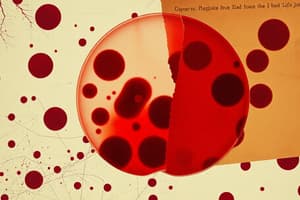Podcast
Questions and Answers
Which of the following is a primary function of blood?
Which of the following is a primary function of blood?
- Producing digestive enzymes
- Transporting nutrients and waste (correct)
- Synthesizing hormones
- Filtering air for respiration
What percentage of blood volume is typically made up of plasma?
What percentage of blood volume is typically made up of plasma?
- Approximately 25%
- Approximately 75%
- Approximately 95%
- Approximately 55% (correct)
Which of the following is the most abundant type of protein found in blood plasma?
Which of the following is the most abundant type of protein found in blood plasma?
- Fibrinogen
- Globulins
- Hemoglobin
- Albumins (correct)
What is the main function of erythrocytes?
What is the main function of erythrocytes?
Why do red blood cells lack a nucleus?
Why do red blood cells lack a nucleus?
Which type of white blood cell is most associated with fighting off bacterial infections?
Which type of white blood cell is most associated with fighting off bacterial infections?
Which of the following components of hemoglobin binds to oxygen?
Which of the following components of hemoglobin binds to oxygen?
Which formed element protects against blood loss?
Which formed element protects against blood loss?
Flashcards
Blood Functions
Blood Functions
Transports O2 and CO2, nutrients, hormones, heat, and waste; regulates pH, temp, fluid balance; protects against pathogens/blood loss.
Hematocrit
Hematocrit
The percentage of the volume of all formed elements/cells in blood.
Blood Plasma
Blood Plasma
Liquid component of blood (~55% of volume); transports nutrients, electrolytes, hormones, and waste.
Albumins
Albumins
Signup and view all the flashcards
Fibrinogen
Fibrinogen
Signup and view all the flashcards
Red Blood Cells (Erythrocytes)
Red Blood Cells (Erythrocytes)
Signup and view all the flashcards
Hemoglobin
Hemoglobin
Signup and view all the flashcards
White Blood Cells (Leukocytes)
White Blood Cells (Leukocytes)
Signup and view all the flashcards
Study Notes
- Blood transports formed elements, dissolved molecules, and ions.
- It carries oxygen to and carbon dioxide from the lungs.
- Blood regulates body temperature by absorbing and releasing heat.
- Buffers in blood absorb acids and bases, maintaining body pH.
- Blood protects against pathogens with leukocytes and plasma proteins.
- Platelets and plasma proteins protect against blood loss.
- Hematocrit is the percentage of volume of all formed elements in blood
- Clinically, hematocrit refers to the percentage of erythrocytes in blood.
Blood Plasma
- Blood plasma accounts for approximately 55% of blood volume.
- It consists of about 90-92% water and 8-10% dissolved substances.
- Dissolved substances include electrolytes (Na+, K+, Ca2+, Cl-, HCO3-), nutrients, waste products, hormones, and gases (O2, CO2, N2).
Important Blood Proteins
- Albumins are the most abundant blood proteins (58%).
- Albumins exert colloid osmotic pressure and transport lipids, hormones, and ions.
- Fibrinogen is a key protein involved in blood clotting.
Red Blood Cells (Erythrocytes)
- Red blood cells are small, flexible, biconcave discs lacking a nucleus and organelles.
- They are packed with hemoglobin and transport oxygen and carbon dioxide.
- The absence of a nucleus allows for more hemoglobin capacity, enhances flexibility, promotes efficient gas exchange, and increases lifespan to 120 days.
- Hemoglobin is a red-pigmented protein that transports oxygen and carbon dioxide.
- It consists of four globin chains (two alpha, two beta) each containing a heme group with iron that binds to oxygen.
White Blood Cells (Leukocytes)
- White blood cells are part of the immune system and defend against infections and abnormal cells.
- Neutrophils fight bacterial/fungal infections.
- Lymphocytes consist of B cells (producing antibodies) and T cells (attacking infected/cancerous cells).
- Monocytes become macrophages, engulfing pathogens and dead cells.
- Eosinophils combat parasites and mediate allergic reactions.
- Basophils release histamine during allergic responses.
Blood Types and Compatibility
- Blood types are determined by A, B, and Rh antigens on red blood cells
- Blood types include A, B, AB, and O, with the Rh factor (+/-)
- Incompatible transfusions can cause hemolysis and agglutination, leading to serious reactions.
- Careful cross-matching is essential before transfusions.
Studying That Suits You
Use AI to generate personalized quizzes and flashcards to suit your learning preferences.




